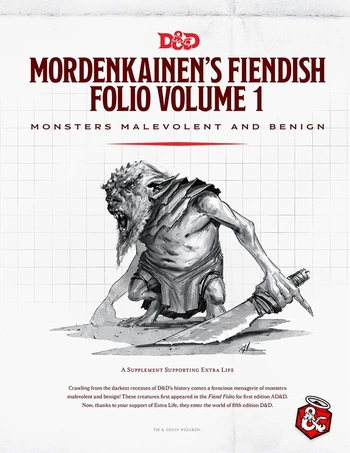 So, I didn't really think we would make it this far, but here we are. We went through the three primary bestiary books for the fifth edition of Dungeons & Dragons, and since we started this little wacky journey of talking about all of D&D 5E's monsters, we've gotten a little bonus supplementary bestiary released in December 2019 as a downloadable online PDF, Mordenkainen's Fiendish Folio, Volume 1: Monsters Malevolent and Benign. The fact that this is a volume 1 means that hopefully we'll be getting more of these! Also, this online material is done in cooperation with Extra Life, so I can get a little mini D&D bestiary while also donating to cancer research. That's a nice bit of goodness.
So, I didn't really think we would make it this far, but here we are. We went through the three primary bestiary books for the fifth edition of Dungeons & Dragons, and since we started this little wacky journey of talking about all of D&D 5E's monsters, we've gotten a little bonus supplementary bestiary released in December 2019 as a downloadable online PDF, Mordenkainen's Fiendish Folio, Volume 1: Monsters Malevolent and Benign. The fact that this is a volume 1 means that hopefully we'll be getting more of these! Also, this online material is done in cooperation with Extra Life, so I can get a little mini D&D bestiary while also donating to cancer research. That's a nice bit of goodness.So yeah, we'll talk about this book first, and it's a neat callback to one of my favourite books from the first edition of D&D (and, granted, one of the only two or three books I've ever read of 1E), the Fiend Folio, which is famous and infamous because of its... well, let's just say unconventional monsters. The original Fiend Folio had a lot of crazy, wacky creatures that I feel were thrown in to be intentionally weird, and while a fair amount of them ended up being iconic D&D monsters themselves (the Ettercap, the Aarakocra, the Drow, the Gith, the Slaad, the Kuo-toa, the Death Knight, the Shadow Demon, the Flumph and the Bullywug are some of the more high-profile monsters that debuted in the original Fiend Folio) there are some that are a bit more... funky, and a lot of them are often criticized for being weird for weird's sake without any sort of real origin or explanation.
And, well, all of the monsters found in 5E's Mordenkainen's Fiendish Folio are basically 5E versions of a lot of these monsters found in the original Fiend Folio. Suffice to say that one of my eventual projects would be reviewing the original Fiend Folio, but the lack of good pictures of the creatures there online, and the fact that I could sort of talk about a significant chunk of the creatures there in this one means that I'm definitely going to cover this one first. We've got seventeen monsters here, and I absolutely love that all of them are given black-and-white artwork that's meant to be evocative of the original 1E artwork. Sure, side-by-side, the quality of the artwork is obviously different, but I do really love that some of the artwork (look at the Blindheim or the Fog Giant here) do employ a bit of stylistic minimalism to mimic the inking methods of the time. I do appreciate that.
As a side-note, I tried my best to scrounge up the previous editions' artwork for most of these monsters, but some either never had good artwork in previous editions or never had them scanned and uploaded to the internet. (And honestly, that's perhaps the biggest reason why I haven't done more reviewing monster segments outside of 5th Edition).
- Click here for the previous part, where we cover the final batch of monsters from Mordenkainen's Tome of Foes.
- Click here for the next part of Reviewing D&D Monsters, covering the first batch of adventure modules.
- Click here for the index.
________________________________
Assassin Bug
The Assassin Bug is a real thing, with the Reduviidae family containing some 7000 species. They are named as such because of the extremely powerful sting delivered by their needle-like proboscis, which is painful to humans (it's apparently more painful than the sting of a wasp) and positively deadly to the other insects they prey on, with the assassin bugs injecting a liquefying enzyme that turns their prey into soup. D&D's Assassin Bugs are classified as 'monstrosities', and in 5E, they look pretty cool, very insect-like but with the arrangements of their bug legs arranged in a humanoid form. I'm not sure if it's just the art stylization or if the Assassin Bug's wings are meant to look tattered. 1E's Assassin Bug, on the other hand, is basically just The Fly. And there's a sense of goofy charm to the original Assassin Bug (and it's also pretty unconventionally dumb-looking whereas badass bug monsters are basically every other bug monster in 5E's repertoire), but on the other hand, the 5E artwork is such a cool bug monster that it's really hard for me to really favour one over the other.
Interestingly, the 5E lore describes the Assassin Bug as resembling 'giant bluebottle flies', a description that fits the original Assassin Bug down to a T, but the 5E Assassin Bug definitely looks like it's more of an amalgamation of more sleeker-looking and let chunky, fat-looking flies. Unlike real life Assassin Bugs, D&D's Assassin Bugs are also parasitic, doing the whole Alien thing of stabbing their enemies with their ovipositors and injecting their eggs alongside a paralytic toxin that will grow into maggots that eat their hosts alive. It's more parasitic wasp than assassin bug, inspiration-wise, but it definitely fits the vibe of a D&D monster for sure! Mordenkainen posits a couple of various origins to the Assassin Bug, and apparently clues point to them being created by the normally-benign druids, and we're not sure if it's a benign experiment to create what's essentially an organic corpse-disposal machine that went rogue, or if the druid sect created a biological weapon to wipe out those damn tree-cutting humanoids.
As a huge fan of the Alien franchise and of parasitic animals in general, I'm a big fan of the Assassin Bug. They're honestly not that dangerous in combat, being a mere CR 3 monster, but I really do like the description that Mordenkainen's Fiend Folio tells us, noting how many villages in the frontier have been wiped out by these plagues, how a single bug that escapes can cause a lot of devastation and turn a village into a hive for these creatures, and how sometimes kingdoms and adventurers have to burn down entire villages to curb the infestation... and I do love how this is going to give your characters a way to basically make hard decisions. The 5E Fiend Folio also gives us a pretty nasty description of trolls that will allow Assassin Bugs to lay their young within their regenerating flesh just to have a parasitic snack they can chomp on.
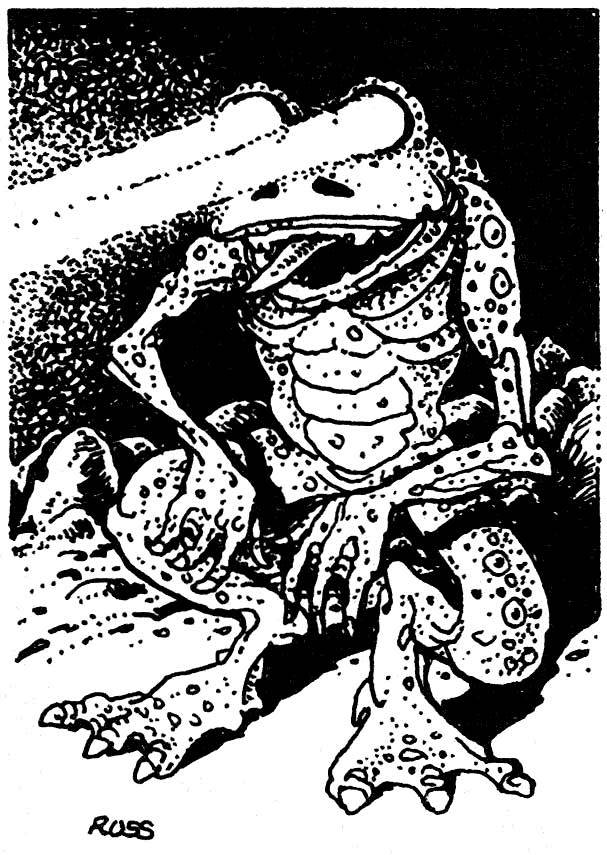
Blindheim
Yet another one in D&D's many, many frog monsters are the Blindheim. I do appreciate that the 5E artwork still keeps a lot of the goofy charm of a frog monster with strobe-lights. Sure, the hunched-over position and the more threatening fang does make 5E Blindheim look more like a threat than the goofy 1E Kermit, but they do keep a sense of wackiness to the Blindheim. And, hey, it's a freaking frog-man with eyes that shoot out beams of light to blind you when you're traveling in Underdark caves. There's a definite amount of silliness to the Blindheim for sure (nevermind the fact that blinding someone with a sudden burst of light is technically a pretty logical defense mechanism for a cave-dwelling creature), and I think for the longest time I've only been aware of the Blindheim in endless lists of 'stupidest monsters in D&D' or something. While it's just one of the many monsters in the original Fiend Folio where the description is just talking about how the strobe-frog behaves in combat, 5E actually turns the Blindheim into an actual intelligent race in the vein of the kobolds or kuo-toa. They are still ambush predators so it's definitely possible to just have the Blindheim show up as a one-note encounter. But it's also noted that Blindheims are easily swayed into service for anyone who pays them with fresh food, weapons, and general weird things like plants and trinkets from the surface world, and that there's some mystery to their backstory, where the Blindheims speak of an ancient time when their ancestors once lived on the surface, stole a piece of the sun before fleeing to the Underdark and consuming the power of the sun itself to gain its power, but there's a prophecy that the sun will venture into the Underdark to have its revenge. That's a nice backstory!
The Blindheim's eyes now deal radiant damage, which is the same sort that things like priest and paladin spells do, which... hey, if these frog-men can emit light from their eyes, why not radiant light, right? The fact that a lot of Underdark creatures have sunlight sensitivity (like the Underdark variants of the drow and dwarves) actually make it a lot more logical for the Blindheim to be useful as mercenary allies. My favourite feature, though, is that as a race, the Blindheim are extremely suspicious of the sun, imploring their mercenary allies from the surface to tell them if the sun is angry, and to not tell about their behaviour to the sun. Overall, a very neat upgrade! They kept everything that's necessary about the goofy 1E strobe-light frog-men, gave them an actual backstory and some culture, and even made them actually kind of cool in combat.

Crab Folk
Known as "Crabmen" in the original Fiend Folio, the Crab Folk are... certainly a lot more different than their original 1E counterpart. Look at those 1E Crabmen. They sure have crab pincers, but between the beak and the lack of anything crab-esque, they look more like a bunch of Star Trek aliens found themselves in a cave. 5E's Crab Folk goes all in with making them truly crab-like, and crabs in general are pretty badass-looking when you exaggerate their features. That crab face, those giant pincers, the huge shell on their back... and it's also got a definite humanoid body layout, making it not just a giant crab. Interestingly, the Crab Folk are classified as 'giants' in 5E, which is one of the more exclusive and rarer tags that has been given out. Turns out that 5E Crab Folk are actually originally ogres, transformed by a green hag in ages past to help guard a coastal region (because they are so dumb they kept drowning, silly ogres), and creating a whole new race. It's interesting to note that the Crab Folk are normally peaceful hunter-gatherers that live in quiet settlements, but sometimes 'when the conditions are right', the magic that created them causes them to lash out like actual monsters. What's the condition? A seagull arriving when the seasons change from summer to autumn -- which is extremely specific, and is apparently a holdover from the original hag's orders that's embedded in the Crab Folks' magic, because the hag used to have a seagull familiar that barked war orders to the original Crab Folk. They also have a gigantic compulsion to get silver items (again, because of the hag's orders) and worship an effigy of their creator... but it's heavily implied that the green hag that created these Crab Folk has long passed away, and it's really interesting that the entire race are basically doing things to appease a god-like entity that has died long ago, and there's no real way to stop these stray bits of magic from spurring them on. Not my favourite thing in this book, but it's still a very cool-looking crab monster.

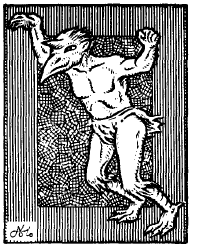
Dire Corby
A corby is an old Scottish term for the common raven, but the Dire Corby isn't just a huge, scarier version of a regular corby, but rather a creepy-looking crow-man. 5E's Dire Corby has a pretty wonderful artwork that really highlights how unsettling a raven's dead-white eyes could look next to the long, smooth beak, although I also do like the hideous, mottled 4E Dire Corby. Originally just a race of men with bird heads and feet, 4E and 5E's art update makes them significantly more creepy-looking with anatomically accurate raven heads. 5E's Dire Corbies are noted to travel in large packs (large murders, since these are technically ravens) and they just basically strip all the tunnels they pass through of life, basically making them creepier, man-sized locust swarms, and it's noted that this is basically a twisted versions of the traveling patterns of a migratory bird... and I do like the little bit of detail noting that Underdark travelers will prize maps that lay out the migrations of these giant flocks of Dire Corbies, which would allow them to walk through tunnels where the Dire Corbies have helped to clean up the monsters that would've otherwise be troublesome.
A Dire Corby's signature move is creating a massive cacophony that disorients and disables their prey, instilling a sense of vertigo and causing spellcasters to be unable to cast all but the most basic of spells. Again, the Fiend Folio notes that many inventive (and crazy) adventurers have found a way to mimic the sounds of a Dire Corby, allowing them to be accepted into the flock and essentially travel under the protection of the simple creatures. Perhaps not the most exciting monster, although I do like the concept of a moving swarm of destruction that's just sort of accepted as part of the Underdark fauna. While the previous bestiaries highlighted more about the cultures of the Illithids, Drow and Duergar that live in the Underdark, I have a sense that this Fiend Folio is trying to expand more on the wacky underground creatures of the Underdark.
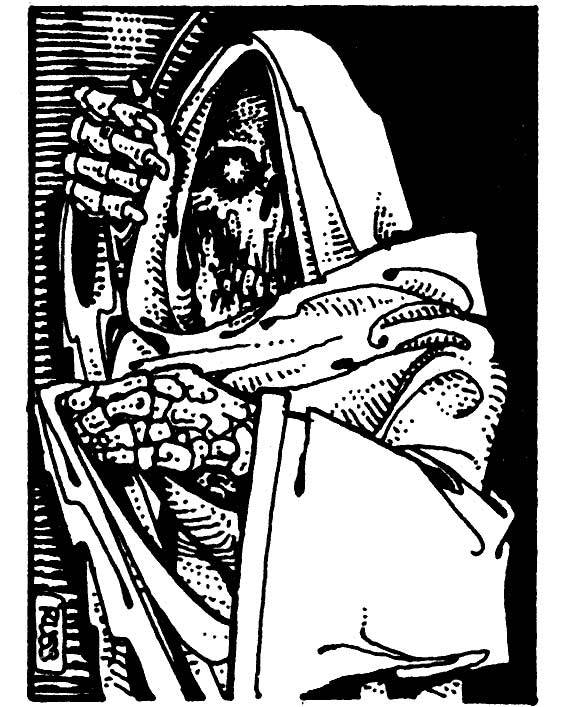
Eye of Fear and Flame
There are many wacky skeleton-men in D&D, and sometimes it's going to be confusing whether you're fighting a regular skeleton mage, or a lich, or a deathlock, or a wight, or a death knight... yeah, some skeleton monsters do have distinctive parts of anatomy that make them easily distinguishable, like the boneclaw's giant fingers, the devourer's chest-incubator-thing or the skull lord's three heads, but the Eye of Fear and Flame is one whose appearance is basically a skeleton in robes. You might be forgiven for thinking that it's basically just another good old skeleton when it turns out that, hey, it's a far more dangerous monster. It's no lich, for sure, but it's definitely an intelligent skeleton monster.
The Eye of Fear and Flame's distinguishing features is that its eyes are gemstones, red and black in each eye socket, and, hey, turns out that the name is literal, and one eye casts a fire spell and the other casts a fear spell. It'll turn you into a scared barbeque! And you'd think that glowing eyes would be a real giveaway, but the Eye of Fear and Flame is intelligent, it's got a hood to cover those eyes that the bio explicitly notes as causing the interior of the hood to look like an opaque black void until it opens it willingly, so you might not even realize that this thing's an undead at all, and just a creepy traveler with a tattered hood. I'm not the biggest fan of its modus operandi, where apparently only twenty of these creatures exist, created by the gods of chaos to basically wander around towns and settlements that are gripped in uncertainty (like during wars or famine) and basically order people to do evil things, just to sow chaos. There's a neat sense of an urban legend quality to this thing, though -- disobey the Eye of Fear and Flame's mysterious and usually-evil orders, and it will open its hood and beam you with its gemstone eyes. Kinda like a Kuchisake-onna, huh?

Forlarren
The Forlarren are gangly, skinny-looking mutant satyrs with a very wretched-looking face. They kinda look like a generic hobo-satyr in the first edition artwork, while the 5E version poses them as if they're floating in the air. They're the descendants of satyrs corrupted by a bargain with devils, and is described as being the bizarre union between the rigid demands of the devils and the impulsiveness of the Feywild. It's interesting that the creation of the Forlarren basically ended up thanks to the weird laws governing souls -- the archdevil Fierna attempted to court a mighty fey lord, but failed... but not before the fey lord's satyr minions were corrupted by the dark delights of hells... but are unable to bargain away their souls because they were bound to their fey lord, so these corrupted satyrs and their descendants are trapped between two worlds, rejected by both devils and fey alike. In practice, this means that the Forlarren are extremely unpredictable with insane amounts of mood swings, since they're basically got two extremes of personalities stuck inside a single mind, going from a drunken local guide to psychotic and calculating murderer within moments. It's sort of Gollum-esque, and it's definitely an interesting way to portray an NPC or two that your party member might meet in your journeys. Not my favourite monster here, but it's still a pretty interesting concept.
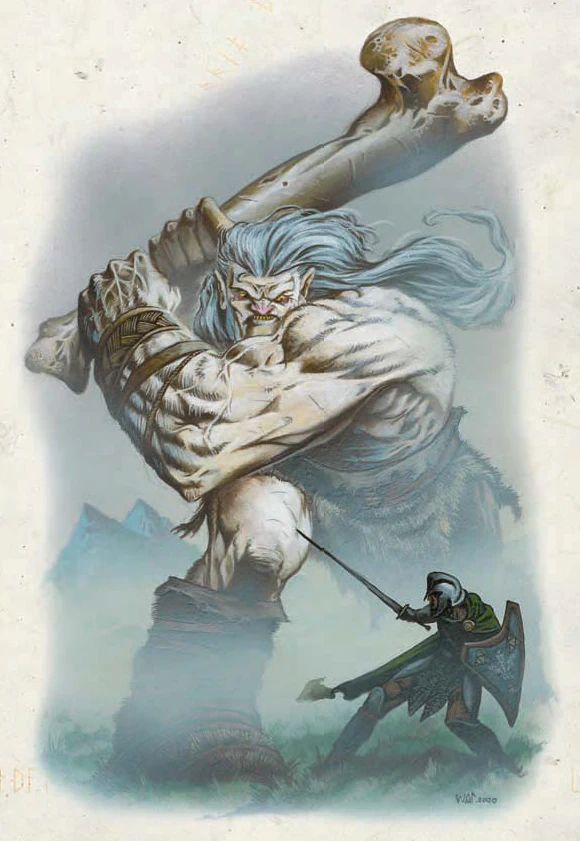
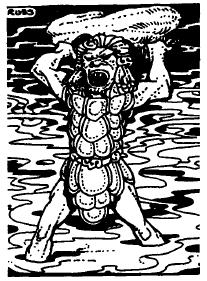
Fog Giant
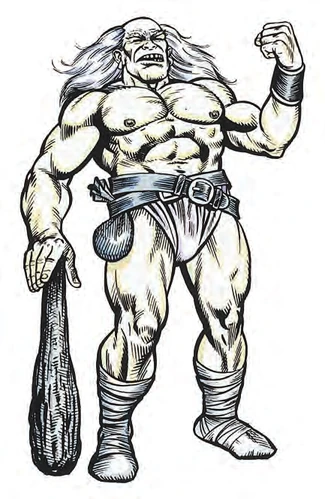 Now this one, I remembered seeing all over the place in the 2E and 3.5E edition. They're never quite placed on the same level as any of the classic, original D&D giants, but I feel like whenever they decide to expand the giants, they tend to go with the fog giants as the default one. They're always noted to be offshoots of cloud giants in most editions, and tended to be the more brutish, barbarian-esque versions of their proud cloud giant brethren. In 5E, the fog giants are explicitly noted to be cloud giants that have fallen from grace due to losing their wealth (which is a huge thing in cloud giant society), and they basically become raiders trying to reclaim their wealth by any means possible, living the peasant life of raiding other races while also longing and pretending that they're still barons and princes. I do find the 5E artwork to look particularly interesting, with sallow and almost thin features compared to the brutish, mountain-barbarian-msucle-men vibe of the 3E and 2E Fog Giants. It is kind of interesting that these guys are basically just cloud giants that are now poor and fallen from grace, and will do anything to try and get their hands on treasures and those oh-so-important refinement for their upper-class life. Hell, even when they bully other bandits to be their minions, fog giants basically only want 'civilized' races like humans and dwarves, and tend to end up being the leader of a huge thieves' guild or something. It's a far more interesting update, I feel, even if the lore now barely mentions the 'fog' part of its name (they have the capability to cast fog cloud and can blend into them, but it's an afterthought) but the whole backstory about being cloud giants fallen from grace is admittedly more interesting than 'giants, but they make fog'.
Now this one, I remembered seeing all over the place in the 2E and 3.5E edition. They're never quite placed on the same level as any of the classic, original D&D giants, but I feel like whenever they decide to expand the giants, they tend to go with the fog giants as the default one. They're always noted to be offshoots of cloud giants in most editions, and tended to be the more brutish, barbarian-esque versions of their proud cloud giant brethren. In 5E, the fog giants are explicitly noted to be cloud giants that have fallen from grace due to losing their wealth (which is a huge thing in cloud giant society), and they basically become raiders trying to reclaim their wealth by any means possible, living the peasant life of raiding other races while also longing and pretending that they're still barons and princes. I do find the 5E artwork to look particularly interesting, with sallow and almost thin features compared to the brutish, mountain-barbarian-msucle-men vibe of the 3E and 2E Fog Giants. It is kind of interesting that these guys are basically just cloud giants that are now poor and fallen from grace, and will do anything to try and get their hands on treasures and those oh-so-important refinement for their upper-class life. Hell, even when they bully other bandits to be their minions, fog giants basically only want 'civilized' races like humans and dwarves, and tend to end up being the leader of a huge thieves' guild or something. It's a far more interesting update, I feel, even if the lore now barely mentions the 'fog' part of its name (they have the capability to cast fog cloud and can blend into them, but it's an afterthought) but the whole backstory about being cloud giants fallen from grace is admittedly more interesting than 'giants, but they make fog'.
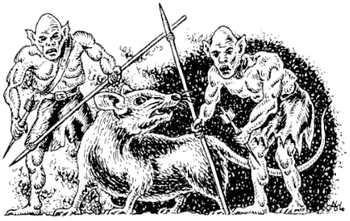
Jermlaine
Awww, look at that adorable artwork of the Jermlaine hanging out with his mouse buddy under a bunch of rock. That mouse looks so happy! And the 5E Jermaline certainly looks a lot less 'hideous humanoid' like the gonk-y fairy tale troll creature from 3E. I think the name 'Jermlaine' is an intentional corruption of 'gremlin'? I don't think I've actually seen the term 'gremlin' show up in D&D, come to think of it. Despite their adorableness, the jermlaine is noted to be neutral evil, and described as 'cruel and malevolent'. Jermlaines basically hide out in little nooks and crannies in the Underdark (again, more Underdark monsters) and wait for moments of opportunity where they have the right amount of numbers to beat up drows and duergars. Their skin are basically textured like stone, making them invisible to any creature with darkvision due to physics or magic or something.
And the reason for this? They hate and resent all large creatures, because big creatures will prey and bully smaller creatures (or, in Underdark creatures' case, harvest their skin to make stealth cloaks). And so the entire race has basically made up this angry crusade to wipe out the big folk. They are also able to communicate and control rats, meaning that the presence of rats is usually a sign that there is a Jermlaine infestation somewhere. I really do love the little note that the master wizard Mordenkainen stuck, post-it-note style, on the 5E Fiend Folio, noting that the easiest way of dealing with Jermlaines is to cast an enlarge spell on one of them, causing the rest of the colony to turn on the 'size traitor' that has joined the big folk.
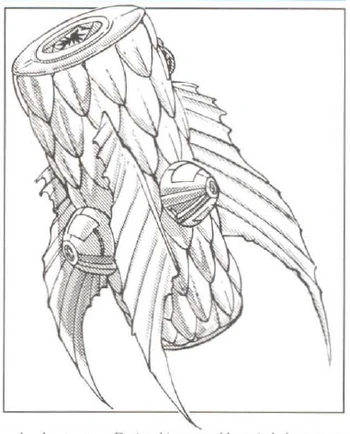
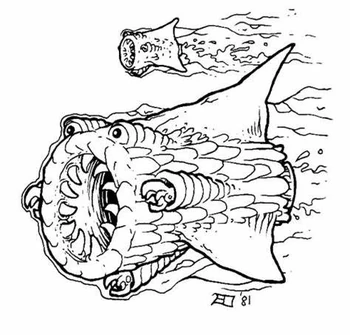
Khargra
What the fuck is this? Something right out of the same sort of wacky design mentality that created the Xorns, the 5th Edition Khargra is actually probably my least favourite version of the creature. And don't get me wrong, it's still a very cool monster, with multiple legs around a cylindrical body and a flower-like set of four jaws and a bunch of eyes around it, but it also feels a fair bit more mundane from the positively alien-looking rocket-cylinders of 1E and 2E. Those things are basically just little cylinders that end in maws, with a bunch of weird eyes that either point outwards like a bizarre robot (2E) or littered almost haphazardly around the circumference of the mouth... and those bizarre fins that make the Khargra look like they're swimming in the water like some sort of bizarre alien approximation of a fish... except that the Khargra are earth elemental creatures and they 'swim' through dirt and rock and the air. There's a completely bizarre, alien vibe to 1E and 2E's Khargra, and while 5E's Khargra is undoubtedly very cool, it's also almost animal-like in how it's drawn. I dunno.
Still, either way, all the Khargras look bizarre. 5E's Khargra is noted to fly through the air, hunting down metal ores and particularly loves refined and crafted metals. They're essentially the version of dirty raccoons in the Elemental Plane of Earth, scavengers that are barely worth noticing, but on the off-chance that they accidentally enter the material plane through a mis-summoning, they will basically go wild and hunt down all the metals in vicinity. Which means, yes, your +3 Broadsword. Thankfully, they don't find gold to be palatable. Apparently people in the material world like dwarves and duergar have trained khargas as couriers, putting secret messages coated in iron and feeding it to the Kharga, and the Kharga will burrow through the earth and vomit out the non-iron message scroll. That's such a bizarre, wacky thing. Ultimately, a very, very bizarre little weirdo.
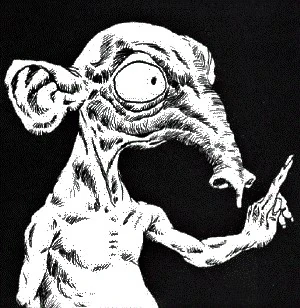

Killmoulis
Apparently the Kilmoulis is a real-life mythological creature from the Anglo-Scottish border, although D&D spells it as Killmoulis. D&D's Killmoulis is also classified as a fey creature, and I do like how relatively consistent its portrayals over the years has been, as a skinny, skeletal humanoid with overly long arms and a weird tapir-like nose-mouth that they use to store candy and nuts in. 5E's version of the creature is described as being one of those fair-weather fair folk with no real allegiance to anyone. If you keep feeding it treats (or let it pilfer it from your supplies), it'll help you mend armor, collect herb and generally be a helpful buddy. But if you bully or neglect it, the Killmoulis will sabotage any sort of journey your party takes by making all your food taste like ash and all your resting attempts be disturbed by cramps and rashes. A lot of 5E's lore associate fey creatures with actions made by mortals in the mortal realm, and the Killmoulis are apparently created whenever someone does an act of charity, but the Killmoulis itself is just kind of a cheeky, mischievous soul that just go around in search of anyone interesteing that'll give it free treats. So it's like a stray puppy or kitty. I really do like that the visual appearance of the Killmoulis isn't even that friendly-looking. Sure, it's not obviously evil, but without context, the Killmoulis isn't immediately more obviously good-aligned compared to, say, the Jermlaine or Forlarren.
I do like the bit of the Killmoulis being described as something of a double-edged sword. Sure, sometimes your party being selected by a Killmoulis for the target of their following around might be because a party member brought one too many peanuts in their rations.... but then your group might not be aware that the Killmoulis is a harmless creature that just wants snacks, and it's D&D-land where nine times out of ten, any weird-looking creature is likely evil. I do like that even when you offend a Killmoulis, its 'curse' isn't like, deformity or attempted murder or anything. It's just sticks and stones shoved into your sleeping bags.

Mite
Serving as the cover for the 5E Fiend Folio is the Mite, and... it has nothing to do with the real-life tiny bugs, but is rather yet another fey creature. I could've sworn that 'mite' is also used for a mythological creature, but I can't seem to find it. Unlike the Killmoulis, the Mite is a straight-up prick that likes to cause havoc and chaos. Even if it's relatively minor stuff, apparently they are so assholish that even the most veteran adventurers will be frustrated by them. Again, as with most 5E fey creatures, the Mite are born when an associated emotion is felt by a person in the material plane -- namely when someone is so irritated that they lash out in violence, and then gets directed by strange dream to sleepwalk to the nearest tree, dig a hole, scream into it and fill it up. It's such a hilariously specific way that the Mite comes to form, compared to, say, the Killmoulis on this page that just pops into being in the Feywild. The Mites themselves are basically dicks and honestly not that interesting, just a short, deformed old man who shuffle around in underground tunnels and burrows that set traps and cast hexes to annoy anyone who passes. They're just there to literally be dicks and snicker when a group of adventurers can't open a broken lock or become frustrated and argue with each other thanks to the Mites' vexing presence ability. And while the Mites themselves are no more difficult to fight than a giant rat, they don't have to fight you to sabotage your dungeon run, they just sneak about in the tiny sub-tunnels around the dungeons. Not my favourite creature here, but there's definitely some thought put into this one. I probably find it to perhaps be one of the more boring additions in this book, though.
Needle Spawn / Needlefolk
Known as a "Needleman" in the original Fiend Folio, it's described as a creature that looks like a zombie, but is actually a plant-man that shoots out needles from its body. And compared to actually relatively unique-looking plant creatures like the Shambling Mound or the Treant, the Needleman is actually one of the rather sillier creatures in the original Fiend Folio that basically just exists to fool players into thinking this is a regular zombie, with no real rhyme or reason. In 5E, the Needleman has been renamed as the Needle Spawn (or also referred to as 'Needlefolk' by Mordenkainen's post-it notes), and it's basically the Swamp Thing, but instead of goopy plant detritus, it's made entirely out of plant thorns. There's a bit of overlap between the Needle Spawn with something like the blights, I suppose, but hey, more plant monsters for the win, I suppose?
The Needle Spawn are created by a mighty plant creature that hails from regions of the Feywild wracked by violence, the ogre-sized Needle Lords. Since it's born on the battlefield, the Needle Lord ends up taking the emotions from the battlefield and fancies itself as a conquering general. Upon entering a material plane forest, the Needle Lord begins to unleash its young, dropping seed pods all over the place. The seed pods will only reproduce when a humanoid dies nearby, and the seed pod will take over the corpse and basically puppeteer it with the vines it grows out. The Needle Lord being a pretty powerful creature itself, sometimes it will kill humanoids and drop them near seed pods. Which is a nice way to not mock the original concept of the Needleman, but update it in a way that makes it feel like the weird, exotic way that this creature reproduces. The Needle Lord is only concerned with taking over a forest, and honestly, as a relatively low-CR creature with a pretty fun backstory, the Needlefolk are actually a nice starter enemy to lob at a newly-formed group.
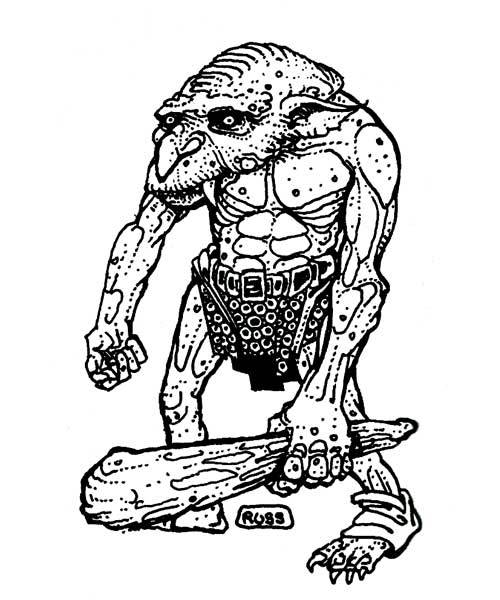
Norker
In the original Fiend Folio, the Norker is just handwaved as identical to hobgoblins, but they have extra fangs and hard skin. No, really, the book basically tells you that other than those features, 'in all other aspects they are similar to hobgoblins'. 5E's Norkers give them a bit more depth, even if the appearance is more or less still basically the same. They're noted to be the most cruel and the most lazy even among goblinoids, and while they have the aforementioned physical mutations that make them an asset in a hobgoblin army... they're lazy asshats that are as likely to sleep or escape from a war camp than to fight. Apparently the norkers were once goblinkind that lived deep beneath the earth before the goblin god Maglubiyet conquered and slew their now-forgotten god, which is the way for them to reconcile the addition of a fourth goblinoid race with the goblinkind lore we got in Volo's Guide to Monsters. The hobgoblin overlords are just so loathe to acknowledge that such lazy, insubordinate scum like the Norkers could claim the honour of being part of Maglubiyet's grand design. They're basically the black sheep of the goblinoid family, but the hobgoblins still keep them around mostly because they're still an asset in battle. It's kind of interesting, I suppose, because they're kind of pariah goblins, but at the same time it's not the most interesting monster concept out there.
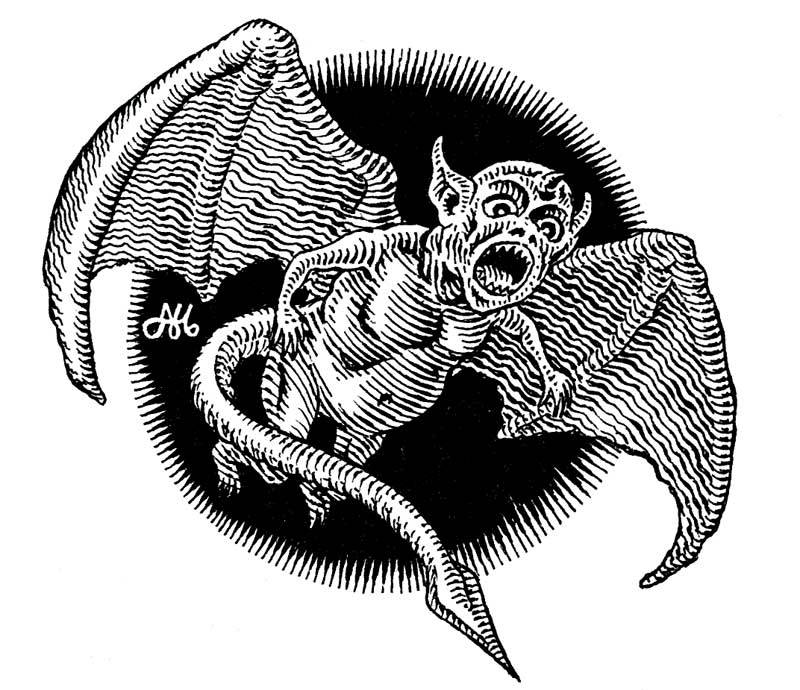
Screaming Devilkin
Despite their name, the Devilkin isn't a devil at all, but rather a fey creature. Design-wise it's honestly pretty basic gargoyle-esque portly devil-man, even if the 5E artwork does make it look pretty damn cool. Like all other fey creatures in this book, the Screaming Devilkin is born thanks to overwhelming moments of panic where the screams echo through the Feywild in a certain manner, taking their appearance from the primal fear inspired by devils. Okay, then. It's an interesting way to reconcile the fact that the original 1E Screaming Devilkin made it a point to hammer home that, no, the Devilkin is not a kin of devils... but doesn't offer any sort of real explanation as to what it is. These little critters are not very powerful and are relatively small, but they attack in small flocks and use their non-stop screaming to incapacitate people and overwhelm them with panic and sensory overload. Apparently, the Devilkin don't really attack to kill, but rather just to injure their victims badly, steal their weapons and supplies, and cause them to lose hope and die slowly. They're sort of like Mites, but are bigger dicks about it. Not the most interesting monster either, but it's a nice update to the otherwise unremarkable 1E version. It's also noted that the Screaming Devilkin will only be quiet only when it's about to ambush, or if it's in subservience to a far more powerful person with a foul soul, like a necromancer or a tyrant. And it's noted that if the Screaming Devilkin are somehow cowed or loyal to a seemingly harmless bandit, it might be a sign that the bandit is far, far more powerful than what he or she seems.
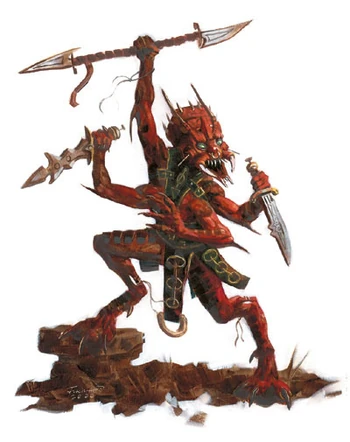
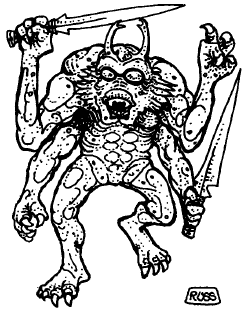
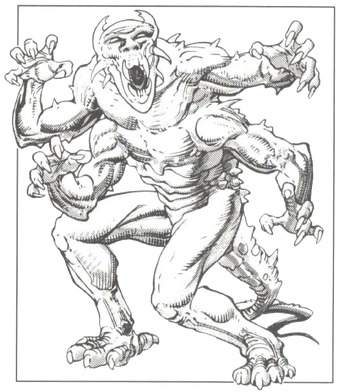 Xill
XillOh, I remember these guys. They show up in the 3.5E basic Monster Manual! And they are these four-armed red-skinned somewhat bug-inspired monsters, which I feel is the most evident in its 3.5E artwork. While a lot of these 5E updates didn't really go full-in by making the monsters super-duper over the top, the Xill got a top-to-bottom refurbish and they're basically turned into like, an agent of the Brood from Marvel comics. Or a Xenomorph. Whichever reference suits your tastes better. And I'm not going to say that the new Xill isn't cool, because it sure as hell is awesome! That sloping back ending in that monstrous maw, the fact that it's got two teeny-tiny T-Rex hands and two massive monster hands, the prawn-like antennae that run down its back... and, hell, it does make the Xill feel a bit more distinct compared to the other bug-man race like the Thri-kreen. And I do really like it, but I feel like there could be a way to preserve at least some more of the goofier look of the original muppet-esque creature.
In 3.5E, we don't really learn anything about the Xill other than it's an extra-planar being who exists only to implant eggs in other creatures, but 5E tells us that the Xill are spawned from a particularly sinister demiplane, which are miniature worlds created by powerful archmages. And, well, the Xill are horrid four-armed lizard-insect fusions that arrive onto the material plane from a demiplane created by the mad wizard Keraptis, paralyze their prey and abduct them back to the Ethereal Plane. 5E's Fiend Folio makes it ambiguous what the Xill does with their abducted victims (with the suggestion that the Xills brainwash them to guard Keraptis's demiplane), maybe so that there isn't too much obvious overlap with the Assassin Bug, but older editions are consistent in having the Xill lay their eggs on the hapless humans. It could be both, I suppose. Either way, it's a pretty cool plane-hopping bug monster.
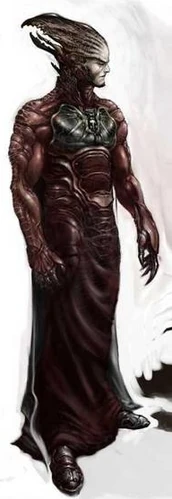
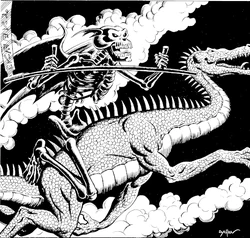

Ygorl, Lord of Entropy
The last monster in Mordenkainen's Fiend Folio is Ygorl, Lord of Entropy, which debuted in 1E's Fiend Folio as "Ygorl, Slaad Lord" and was listed among the Slaad. He is also the only monster in Mordenkainen's Fiend Folio to not have an accompanying artwork (all of these are taken from older editions) because apparently every artist that Mordenkainen sent to draw Ygorl failed to return. And I guess it's actually appropriate for Ygorl's look to be left up to the reader's imagination. After all, as the Lord of Entropy and an embodiment of chaos, should Ygorl even have any sort of permanent form? 1E and 2E depicted Ygorl as a generic skeleton-man with wings riding a dragon, and not that it's not cool... but it's so far removed from the Slaad that I was actually surprised to realize that the connection between Ygorl and Slaad existed since 1E even though the artwork is so wildly different. That 4E artwork, meanwhile, looks more like Volrath from M:TG than a Slaad. In my mental imagination when I first read through the 5E Fiend Folio, Ygorl is just a Slaad dressed in a Halloween Grim Reaper getup.
And Ygorl is, well, basically the big daddy boss of the Slaad, going from plane to plane and unmaking any ecosystem it passes with its entropy powers, while an army of happy Slaadi frog-men follow in its wake. Negotiating with it is different because it's chaos personified. It isn't technically even evil or crazy-evil like Demogorgon or whoever, it just wants to destroy everything as part of its desire to cause the universe to continue in a cycle of destruction and creation. Parleying with him will cause you to go mad, and if you have the misfortune to fight him, Ygorl's a mighty CR 23 creature that will give all but the most powerful demon lords a run for their money, and wields a mighty scythe that will reduce living creatures to ash. It's honestly not the most creative boss out there, although it could be that 90% of his entry in the Fiend Folio is just his super-long stat block. It's neat to give the Slaad a big boss-man, but he's not the most interesting as a monster.
__________________________
And hey, that's it for Mordenkainen's Fiend Folio! At 21 pages, it's not actually very long, and I do feel like there's an interesting sense of trying to expand on the creatures found in the Underdark and the Feywild, and a few specific monsters aside (Ygorl, the Fog Giant and maybe the Eye of Fear and Flame) a lot of these monsters are meant to be more flavourful and to be fought for lower-leveled adventurers. The fey creatures in particular, I feel, are designed more to be vexing encounters instead of combat encounters. A pretty fun little supplementary bestiary for sure! The next D&D Reviewing Monsters segment will bring us back to the first couple of 5E adventure modules, which I was a bit hesitant to initially do... but oh well, we'll see how it goes.
The 5E stats for these creatures. I dunno, I really find it fun to have this little index to refer to just to have a little sight to see the relative size and strengths of these critters.
- Assassin Bug: Medium monstrosity; neutral; CR 3
- Blindheim: Medium humanoid - Blindheim; chaotic neutral; CR 2
- Crab Folk: Large giant; neutral; CR 3
- Dire Corby: Medium humanoid - Dire Corby; neutral evil; CR 1/2
- Eye of Fear and Flame: Medium undead; chaotic evil; CR 9
- Forlarren: Medium fey; chaotic neutral; CR 3
- Fog Giant: Huge giant; neutral evil; CR 11
- Jermlaine: Tiny humanoid - Jermlaine; neutral evil; CR 1/8
- Khargra: Small elemental; neutral; CR 1/8
- Killmoulis: Tiny fey; neutral; CR 0
- Mite: Small fey; lawful evil; CR 1/4
- Needle Spawn: Medium plant; chaotic evil; CR 1/2
- Needle Lord: Large plant; chaotic evil; CR 3
- Norker: Small humanoid - goblinoid; chaotic evil; CR 1/2
- Norker War Leader: Small humanoid - goblinoid; chaotic evil; CR 3
- Screaming Devilkin: Small fey; lawful evil; CR 1
- Xill: Medium monstrosity; lawful evil; CR 3
- Ygorl, Lord of Entropy: Large aberration; chaotic neutral; CR 23
No comments:
Post a Comment